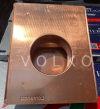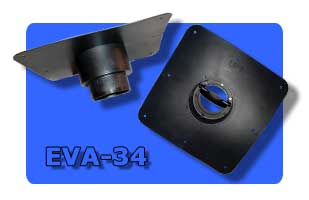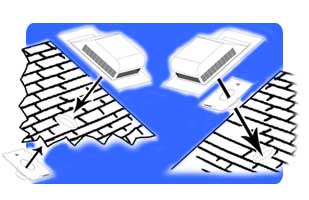|
Copper Roof Vents
Slant Back Copper Roof Vent
Ventilation for asphalt, slate, copper,
metal and tile roofs
 |
 |
 |
 |
| All
Copper Construction |
16" x
20.313" x 5" |
8"
Weather-Tight Seamed Collar |
Fits
All Pitched Roofs |
Copper Static Air Roof Vent Provides 50 NFA (in.²)
Per Vent
Three Sides Louvered for greater air
flow and bird-proof protection.
Add a backdraft damper to almost any roof
vent
Plastic construction, will not rust! Prevents
corrosion of dissimilar metals at connection.
 |
 |
Exhaust vent adapter fits 3" or 4" flexible duct.
10” nailing flange. |
Installs from top of deck or inside of attic
to roof vent. |
Call 1-800-685-8263 or e-mail us at
info@volko.com ]
There is a silent war underway in most
attics and crawlspaces. Insulation, structure, paint and roofing materials are
under attack from heat and moisture. Excessive heat buildup can top 150º
degrees Fahrenheit in an attic. Excessive moisture can actually condense to
water droplets. The only way to get rid of damaging heat and moisture is with a
proper ventilation system of intake and exhaust ventilators. Left unventilated,
heat and moisture can wreak havoc in a home, causing expensive damage. With a
proper ventilation system of intake and exhaust vents, hot humid air is
continually replaced by fresh air, removing excessive heat and moisture.
|
How do
ventilators work?
Is a vent just
a vent? |
|
Ventilation products are all too often
considered a commodity. The lack of proper knowledge leads to the belief
that all cornice vents are alike; a roof louver is a roof louver; there is
no difference between vents, possibly other than price. In truth, however
there is a substantial difference in products.
Product Design - Ventilation
products are designed to achieve two major functions -
capacity to ventilate and weather protection.
1. Capacity To Ventilate -
Intake and roof exhaust are determined by four factors:
A. Thermal Effect - The air
outside of the attic is always colder than the air inside the attic.
Hot air does not rise - cold air pushes it. The opening available
on the cornice vent determines the amount of cold air allowed to
push hot air upward. The exhaust capabilities are determined by the
flue or stack of the exhaust ventilator. The process works much
like a chimney or stove pipe. Using roof louvers as an example,
compare various products and their flue or collar.
B. Wind Pressure - Outside air
moving across the exhaust ventilator creates a pressure difference
causing the ventilator to draw depending on design. Product design
determines true exhaust capabilities.
C. Centrifugal Force - This
capability can only be implemented by an electric power source or
wind rotary action. Longevity of the products to perform this
action is key in understanding this ventilation approach.
D. Location on the Roof - The
above factors discussed are positively influenced by application of
the vent on the top one-fourth section of the roof.
2. Weather Protection - The
capacity to ventilate is of utmost importance; however, weather
protection cannot be sacrificed. Weather infiltration develops the
main enemy in the attic, moisture. Product comparison in the field
demonstrates this major factor.
Summary:
There is a great difference in ventilation products available in the
marketplace. The low cost of ventilation relative to the value
enhancement dictates using the most functional products available.
courtesy of http://www.lomanco.com
|
Call 1-800-685-8263 or e-mail us at
info@volko.com
...for all those things you thought were not available in copper.
|